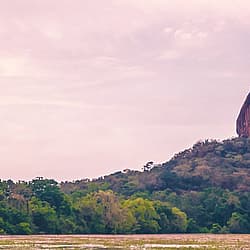The best time to travel in Sri Lanka
Always plan your trip to Sri Lanka for the dry season. The weather differs depending on whether you're in the east or west of the country, so always adapt your travel dates to fit in with the region you want to visit. Generally, the rains move from west to east, so some part of the country is always in sunshine. As long as you know that, you can be sure of having good weather in Sri Lanka.
At a glance
The best time to visit Sri Lanka is in the dry season, which runs from December to March on the west and south coasts and in the mountains, and from May to September on the east coast. The rest of the year, it's monsoon weather, which makes travelling less pleasant. In Sri Lanka, you'll be enchanted by the many treasures from the ancient kingdom of Ceylan: with ancient cities, amazing beaches and the most beautiful mountains, the Sri Lankan environment is breathtaking.
Travel as you wish to Sri Lanka
The South
South Sri Lanka with its paddy fields and palm plantations is guaranteed to delight you. The scenery will take your breath away and the fishing villages never fail to please travellers. If you're a fan of watersports, you can go diving on the superb coral reefs or have a go at surfing. You can also watch whales romping in the ocean, monkeys jumping from tree to tree and you might even catch a glimpse of a leopard! Avoid the monsoon season between the months of May and August as well as October and November which can also be very wet. Try to go in the dry season which runs from December to March.
The Imperial Cities
This is the part of Sri Lanka that's not to be missed if you like visiting ruins and lost cities. The ancient Sinhalese dynasties established their capitals and created their architectural masterpieces in this area, before they were invaded by the jungle. The ancient treasures to be explored have earned this region the title of 'The Cultural Triangle'. This part of the country is affected by heavy rains between May and August. so try to visit in the dry season between December and March. Try to avoid the months of October and November too because they are very wet.
The East
The eastern coast of Sri Lanka has unexplored beaches that stretch as far as the eye can see and multi-coloured Hindu temples. The welcome here is very warm, although the tensions between Sinhalese and Tamils and Tamils and Muslims, for example, are still simmering. Eastern Sri Lanka is still a tropical paradise where few tourists venture. Avoid the rainy season from October to January and visit at other times of the year when the weather is hot and dry and more pleasant.
The North
The differences between the north of Sri Lanka and the rest of the country are quite marked, from the point of view of the language, the cuisine and the landscapes. Because tourists are few and far between here, the locals reserve a particularly warm welcome for them. The rains are very heavy during the monsoon in the northeast, which lasts from October to January. So it's best to visit this area at other times of the year when it's hot and dry.
The Mountains
Kandy is the capital of the mountainous region and constitutes the Sinhalese spiritual and cultural centre of the country. Here, you can see the tea plantations and take part in a wide range of outdoor activities. To the south, there is the Sinharaja Forest Reserve to explore and the Horton Plains National Park to the north. And of course, you need to climb Adam’s Peak. The climate is generally mild but can sometimes be a bit chilly. The hottest part of the year is from March to June. The rains are very frequent from May to August and in October and November. So choose the driest season which runs from December to March if you're visiting this part of Sri Lanka.
Sri Lankan Beaches
You can go to the beach all year round in Sri Lanka … as long as you travel from west to east! In fact, during the monsoon in northeastern Sri Lanka, which lasts from December to March, the sun shines and the weather is great on the beaches of the west and south coasts. Conversely, from May to September, when the monsoon rains are falling on the southwest coast, you can head for the beaches in the east where the weather is perfect! Always avoid October and November which are very wet. Instead head for the beaches at Mirissa or Thalpe on the south coast or for the amazing beach at Marakolliya, for example. On the eastern coast, Arugam Bay is the go-to place for surfers and the isolated beaches of Batticaloa are sure to delight you.
Colombo and the West Coast
Explore Colombo, the administrative, political and economic centre of the country. The capital and the region around it have retained their colonial heritage and the old quarters of the city are also its commercial heart. You will find the city's temples, its little tea shops and craft shops charming. Like everywhere else in Sri Lanka, the average temperature is 25°C in this region, which makes touring very pleasant. The rainy season runs from May to August. In addition, rain and storms are frequent in October and November.






















